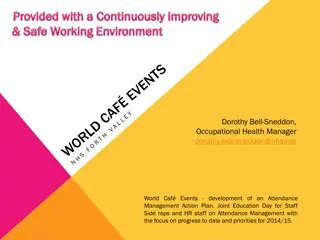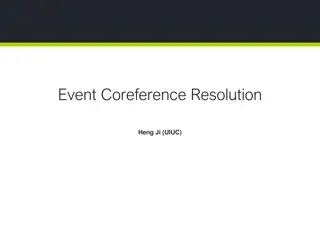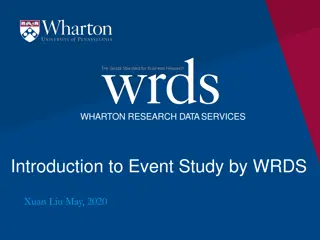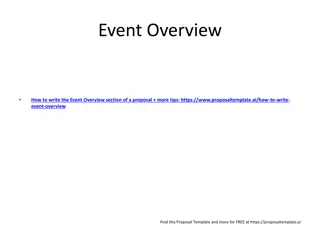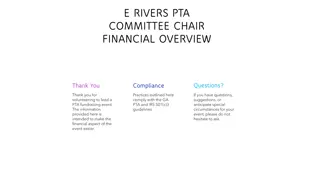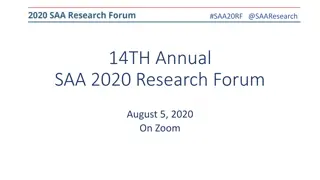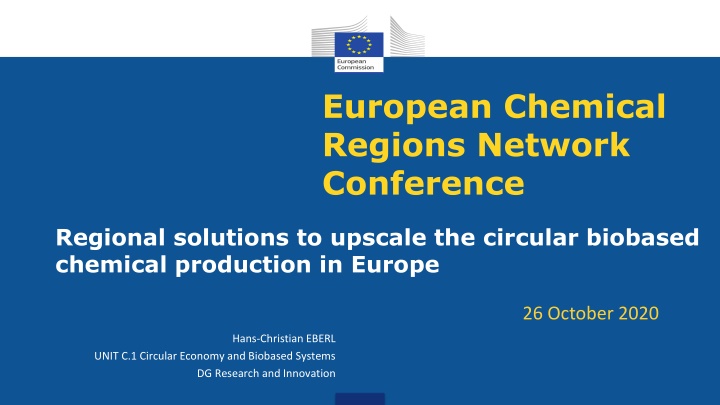
Circular Biobased Chemical Production Solutions in Europe
Explore the regional solutions discussed at the European Chemical Regions Network Conference regarding upscaling circular biobased chemical production in Europe. Key topics include the EU Plastics Strategy, Sustainable Development Goals, Horizon Europe initiatives, and relevant projects focusing on plastics in the environment. Discover how research and innovation are driving progress towards a more sustainable and circular economy.
Download Presentation

Please find below an Image/Link to download the presentation.
The content on the website is provided AS IS for your information and personal use only. It may not be sold, licensed, or shared on other websites without obtaining consent from the author. If you encounter any issues during the download, it is possible that the publisher has removed the file from their server.
You are allowed to download the files provided on this website for personal or commercial use, subject to the condition that they are used lawfully. All files are the property of their respective owners.
The content on the website is provided AS IS for your information and personal use only. It may not be sold, licensed, or shared on other websites without obtaining consent from the author.
E N D
Presentation Transcript
European Chemical Regions Network Conference Regional solutions to upscale the circular biobased chemical production in Europe 26 October 2020 Hans-Christian EBERL UNIT C.1 Circular Economy and Biobased Systems DG Research and Innovation
Policy context Sustainable Development Goals 2015 Circular Economy Action Plan 2015 Plastics in a Circular Economy 2018 A Circular Economy for Plastics (R&I) 2019 European Green Deal and Annex 2019 Circular Economy Action Plan 2020 Horizon Europe 2020
EU Plastics Strategy Key priorities supported by R&I in Horizon 2020 Improving recyclability of plastics (LEIT, SC2, SC5) Innovative sorting and recycling technologies (LEIT, SC5) Prevention and cleaning up of marine litter and plastic debris (SC2) Microplastics (SC1, SC2, SC5) Alternative, non-fossil feedstocks, including bio-waste (SC2) Chemicals of concern (SC1, SC5)
EU Plastics Strategy relevant topics in H202 WP 2020 SC1-BHC-36-2020: Micro- and nano-plastics in our environment: Understanding exposures and impacts on human health SFS-21-2020 - Emerging challenges for soil management (impact of micro plastic on soil properties and its ecosystem services function, use of plastics in agriculture, SC2) CE-BG-06-2019: Sustainable solutions for bio-based plastics on land and sea (SC2) BG-07-2019-2020: The Future of Seas and Oceans Flagship Initiative: [C] 2020 - Technologies for observations (SC2) CE-FNR-09-2020: Pilot action for the removal of marine plastics and litter (SC2) CE-SC5-24-2020: Improving the sorting, separation and recycling of composite and multi- layer materials CE-SC5-25-2020: Understanding the transition to a circular economy and its implications on the environment, economy and society CE-SC5-28-2020: Develop and pilot circular systems in plastics, textiles and furniture sectors CE-SC5-29-2020: A common European framework to harmonise procedures for plastics pollution monitoring and assessments CE-SC5-30-2020: Plastics in the environment: understanding the sources, transport and distribution of plastics pollution CE-BIOTEC-09-2020: Upcycling bio plastics of food and drinks packaging (LEIT)
Call Greening the economy in line with the Sustainable Development Goals Connecting economic and environmental gains - the circular economy CE-SC5-24-2020: Improving the sorting, separation and recycling of composite and multi-layer materials CE-SC5-25-2020: Understanding the transition to a circular economy and its implications on the environment, economy and society CE-SC5-28-2020: Develop and pilot circular systems in plastics, textiles and furniture sectors CE-SC5-29-2020: A common European framework to harmonise procedures for plastics pollution monitoring and assessments CE-SC5-30-2020: Plastics in the environment: understanding the sources, transport, distribution and impacts of plastics pollution
Call Competitive, Low Carbon and Circular Industries CE-SC5-31-2020: Develop, implement and assess a circular economy oriented product information management system for complex products from cradle to cradle Green Deal Call LC-GD-3-2-2020: Demonstration of systemic solutions for the territorial deployment of the circular economy
Horizon Europe structure Six clusters: Health, Culture, Security, Digital, Climate, and Cluster 6: Food, Bioeconomy, Natural Resources, Agriculture and Environment Cluster 6 paradigm: transformative change of EU economy and society; reducing environmental degradation; better management of natural resources; serving the EU s climate objectives Cluster 6 destinations: Biodiversity, Food Systems, Circular Economy and Bioeconomy Sectors, Zero Pollution, Climate Action, Communities, Governance
Horizon Europe strategic planning 2021-2022 Cluster 6 destination 3, Circular Economy and Bioeconomy Sectors Indicators and methods for measuring CE transition Analysis of circular value chains Life cycle information data base Circular cities and regions initiative Circular material streams: plastics, textiles, electronics; construction and buildings; packaging and SUP Novel feedstocks; biobased innovation; bioplastics
Thank you! #InvestEUresearch http://ec.europa.eu/research https://ec.europa.eu/info/horizon-europe-next-research-and- innovation-framework-programme_en













